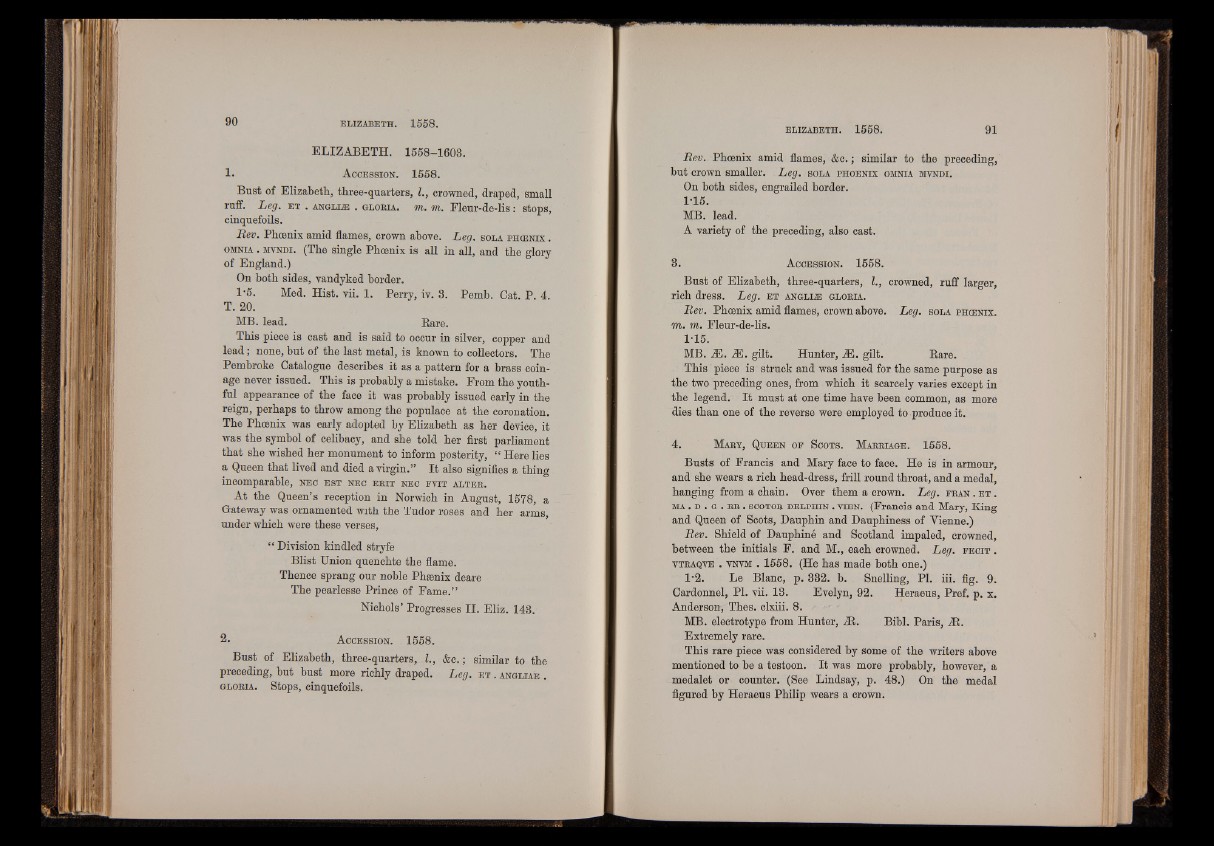
ELIZABETH. 1558-1608.
1. A ccession. 1558.
Bust of Elizabeth, three-quarters, L, crowned, draped, small
ruff. Leg. e t . a n g l l z e . g l o r i a , m. m. Fleur-de-lis: stops,
cinquefoils.
Rev. Phoenix amid flames, crown above. Leg. s o l a p h c e n ix .
om n ia . m v n d i. (The single Phoenix is all in all, and the glory
of England.)
On both sides, vandyked border.
1-5. Med. Hist. vii. 1. Perry, iv. 8. Pemb. Cat. P. 4.
T. 20.
MB. lead. Bare.
This piece is cast and is said to occur in silver, copper and
lead; none, but of the last metal, is known to collectors. The
Pembroke Catalogue describes it as a pattern for a brass coinage
never issued. This is probably a mistake. Prom the youthful
appearance of the face it was probably issued early in the
reign, perhaps to throw among the populace at the coronation.
The Phcenix was early adopted by Elizabeth as her device, it
was the symbol of celibacy, and she told her first parliament
that she wished her monument to inform posterity, “ Here lies
a Queen that lived and died a virgin.” It also signifies a thing
incomparable, n e c e s t n e c e r i t n e c f v i t a l t e r .
At the Queen’s reception in Norwich in August, 1578, a
Gateway was ornamented with the Tudor roses and her arms,
under which were these verses,
“ Division kindled stryfe
Blist Union quenchte the flame.
Thence sprang our noble Phaenix deare
The pearlesse Prince of Fame.”
Nichols’ Progresses II. Eliz. 143.
2 . Accession. 1558.
Bust of Elizabeth, three-quarters, I., &c.; similar to the
preceding, but bust more richly draped. Leg. e t . a n g l i a e .
g l o r i a . Stops, cinquefoils.
Rev. Phoenix amid flames, &c.; similar to the preceding,
but crown smaller. Leg. s o l a p h o e n i x om n ia m v n d i.
On both sides, engrailed border.
1*15.
MB. lead.
A variety of the preceding, also cast.
3. A c c e s s i o n . 1558.
Bust of Elizabeth, three-quarters, I., crowned, ruff larger,
rich dress. Leg. e t a n g l i z e g l o r i a .
Rev. Phoenix amid flames, crown above. Leg. s o l a p h c e n ix .
m. m. Fleur-de-lis.
1-15.
MB. M. M. gilt. Hunter, ¿E. gilt. Bare.
This piece is struck and was issued for the same purpose as
the two preceding ones, from which it scarcely varies except in
the legend. It must at one time have been common, as more
dies than one of the reverse were employed to produce it.
4. M a r y , Q u e e n o f S c o t s . M a r r i a g e . 1558.
Busts of Francis and Mary face to face. He is in armour,
and she wears a rich head-dress, frill round throat, and a medal,
hanging from a chain. Over them a crown. Leg. f r a n . e t .
m a . d . G . r r . s c o t o r d e l p h i n . v i e n . (Francis and Mary, King
and Queen of Scots, Dauphin and Dauphiness of Vienne.)
Rev. Shield of Dauphine and Scotland impaled, crowned,
between the initials F. and M., each crowned. Leg. f e c i t .
v t r a q v e . v n vm . 1558. (He has made both one.)
1*2. Le Blanc, p. 332. b. Snelling, PI. iii. fig. 9.
Cardonnel, PI. vii. 13. Evelyn, 92. Heraeus, Pref. p. x.
Anderson, Thes. clxiii. 8.
MB. electrotype from Hunter, At. Bibl. Paris, At.
Extremely rare.
This rare piece was considered by some of the writers above
mentioned to be a testoon. It was more probably, however, a
medalet or counter. (See Lindsay, p. 48.) On the medal
figured by Heraeus Philip wears a crown.